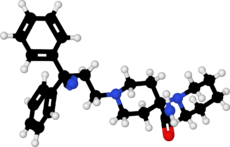Chemistry:Piritramide
 | |
 | |
| Clinical data | |
|---|---|
| Trade names | Dipidolor |
| AHFS/Drugs.com | International Drug Names |
| Pregnancy category |
|
| Routes of administration | Oral, IM, IV |
| ATC code | |
| Legal status | |
| Legal status |
|
| Pharmacokinetic data | |
| Protein binding | 95%[1] |
| Metabolism | Liver |
| Elimination half-life | 4-10 hours (acute dosing), 17.4 hours (chronic dosing) |
| Identifiers | |
| |
| CAS Number | |
| PubChem CID | |
| ChemSpider | |
| UNII | |
| KEGG | |
| ChEMBL | |
| Chemical and physical data | |
| Formula | C27H34N4O |
| Molar mass | 430.596 g·mol−1 |
| 3D model (JSmol) | |
| |
| |
| | |
Piritramide[2](R-3365, trade names Dipidolor, Piridolan, Pirium and others) is a synthetic opioid analgesic (narcotic painkiller) that is marketed in certain European countries including: Austria, Belgium, Czech Republic, Slovenia, Germany and the Netherlands.[3] It comes in free form, is about 0.75x times as potent as morphine and is given parenterally (by injection) for the treatment of severe pain.[3][4] Nausea, vomiting, respiratory depression and constipation are believed to be less frequent with piritramide than with morphine (the gold standard opioid against which other opioids are compared and contrasted), and it produces more rapid-onset analgesia (pain relief) when compared to morphine and pethidine. After intravenous administration the onset of analgesia is as little as 1–2 minutes, which may be related to its great lipophilicity.[5] The analgesic and sedative effects of piritramide are believed to be potentiated with phenothiazines and its emetic (nausea/vomiting-inducing) effects are suppressed.[5] The volume of distribution is 0.7-1 L/kg after a single dose, 4.7-6 L/kg after steady-state concentrations are achieved and up to 11.1 L/kg after prolonged dosing.[5]
Piritramide was developed and patented in Belgium, at Janssen, in 1960. It is part of an eponymous two-member class of opioids in clinical use with the other being bezitramide (Burgodin). The closest chemical and structural relatives of piritramide in clinical use include the diphenoxylate family, fentanyl (both Janssen discoveries) and somewhat more distantly alphaprodine.
Not being in clinical use in the United States, it is a Schedule I Narcotic controlled substance with a DEA ACSCN of 9642 and manufacturing quota of zero.[6]
References
- ↑ "[Drugs for postoperative analgesia: routine and new aspects: Part 2: opioids, ketamine and gabapentinoids]" (in German). Der Anaesthesist 57 (5): 491–8. May 2008. doi:10.1007/s00101-008-1327-9. PMID 18409073.
- ↑ US Patent 3080366
- ↑ 3.0 3.1 "Piritramide". Martindale: The Complete Drug Reference. Pharmaceutical Press. 23 September 2011. http://www.medicinescomplete.com/mc/martindale/current/6259-x.htm.
- ↑ "A clinical investigation of piritramide in the treatment of postoperative pain". British Journal of Anaesthesia 43 (12): 1167–71. December 1971. doi:10.1093/bja/43.12.1167. PMID 4945251.
- ↑ 5.0 5.1 5.2 "FACHINFORMATION (Zusammenfassung der Merkmale des Arzneimittels)". Janssen. Janssen - Cilag Pharma GmbH. November 2013. http://www.janssen-medinfo.at/sites/janssen_medinfo_at/themes/medinfo_at/images/Dipidolor_FI_20131206.pdf.
- ↑ "DEA Diversion Control Division". http://www.deadiversion.usdoj.gov/fed_regs/quotas/2013/fr0620.htm.
 |

